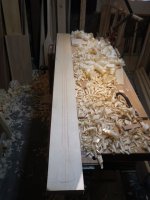This is not going to be a typical build thread. I will stop in occasionally with updates since this canoe is not standard wood/canvas construction. It has some unique features which will aggravate me to no end at some point I'm sure. For the most part I know what I intend to do to restore this grand old boat. This has the potential to be a very long reconstruction and I shant bore any of you with anything you have already seen in Red's thread.
First of all, this boat is fragile in it's present condition. 5 feet of inwale is missing on one side and up to 28 ribs are broken or cracked. It needed to be fortified before any real work could begin on it and I decided to put it into traction for the duration. It has a primarily flat bottom, no rocker to speak of, so I built a strong back to sit it on and then added plywood forms on the sides to hold the structure. It is quite rigid despite not actually being screwed to the structure. If I pull up on the bow it flexes in the middle where the inwale ends, overall though, it is quite solid in it's new foundation.
One thing unique to BN Morris at the time is the pocketed inwales. The ribs sit in pockets in the inwales rather than being nailed to the inside edge. This means that as I replace and repair the ribs the inwales need to come out first. I do need to replace both inwales though so I plan to bend up the new ones before tackling the ribs. We haven't yet sourced 18 foot spruce for the rails but will try to find it somewhere. As with the Huron I did, my plan is to bend up the new rails under the old after soaking awhile, but since I have only one good one, I'm hoping to bend both under the one then just swap one around for the other side, provided the sheer line is the same at both ends it will work.
With one good inwale it had kept the shape on that side, we used the thwarts and seats to pull it back to it's original size, and it should be a torpedo once finished. 32" wide at 17 feet long. I need to shape the plywood forms based on the one good side but I needed a tool to capture the shape. I know I can buy what I wanted but could not get one locally so I made one and it worked fine. I just drew in the full curve as needed. Cut out the good side, made a copy for the poor side. I screwed 2x2 cleats to the outside of the strongback and the ply forms to the cleats.
For now, the boat is stabilized and I can get back to stripping.
The notch in the strongback is for the keel, which is about the only thing keeping the boat from breaking in half.





First of all, this boat is fragile in it's present condition. 5 feet of inwale is missing on one side and up to 28 ribs are broken or cracked. It needed to be fortified before any real work could begin on it and I decided to put it into traction for the duration. It has a primarily flat bottom, no rocker to speak of, so I built a strong back to sit it on and then added plywood forms on the sides to hold the structure. It is quite rigid despite not actually being screwed to the structure. If I pull up on the bow it flexes in the middle where the inwale ends, overall though, it is quite solid in it's new foundation.
One thing unique to BN Morris at the time is the pocketed inwales. The ribs sit in pockets in the inwales rather than being nailed to the inside edge. This means that as I replace and repair the ribs the inwales need to come out first. I do need to replace both inwales though so I plan to bend up the new ones before tackling the ribs. We haven't yet sourced 18 foot spruce for the rails but will try to find it somewhere. As with the Huron I did, my plan is to bend up the new rails under the old after soaking awhile, but since I have only one good one, I'm hoping to bend both under the one then just swap one around for the other side, provided the sheer line is the same at both ends it will work.
With one good inwale it had kept the shape on that side, we used the thwarts and seats to pull it back to it's original size, and it should be a torpedo once finished. 32" wide at 17 feet long. I need to shape the plywood forms based on the one good side but I needed a tool to capture the shape. I know I can buy what I wanted but could not get one locally so I made one and it worked fine. I just drew in the full curve as needed. Cut out the good side, made a copy for the poor side. I screwed 2x2 cleats to the outside of the strongback and the ply forms to the cleats.
For now, the boat is stabilized and I can get back to stripping.
The notch in the strongback is for the keel, which is about the only thing keeping the boat from breaking in half.








